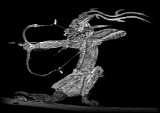
Asian Traditional Archery Research Network (ATARN)
Text and
photographs © Stephen Selby, Alice Kwan, 2001 - 2002.
A1, Cloudridge,
30, Plunkett’s Road,
The Peak, Hong Kong.
Fax: (852) 2808-2887
email: srselby@atarn.org
July 2002
Dear All,
Surrounded by other competitors and on-lookers, Alice is under as much pressure as she has ever been as a sportswoman at a golfing event. She has to get her shot out to over 220 yards. To do that, she will have to hit the ball off the tee with a driver about 45 inches long, striking the ball at 90-100 mph with a 'sweet point' about half an inch in diameter.
Alice Kwan is a Chinese golfer from Hong Kong. A petite four foot nine and weighing 97 pounds, she has had to overcome both physical and psychological problems to prepare herself for this golf driving distance competition.
She tees up; but now her mind is no longer amid a crowd of golfers watching her every move with a critical eye. She is setting up her shot in the middle of an empty golf course on a quiet Sunday morning.
"Anyone who is out in the parade ground under examination conditions is under enormous mental pressure. In such conditions, you have to remain calm and collected, just as if there were no examining officer watching over you and no crowds all around you: you must remain cool and calm. Just imagine yourself practicing by yourself out in the middle of nowhere; that will help you settle your mind and thereby bring you to the height of your powers; you won't let noises startle you or make panicky mistakes…"
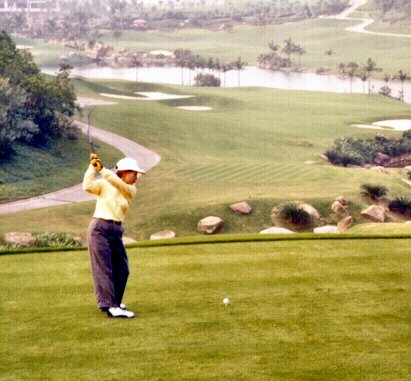
"Just imagine yourself practicing by yourself
out in the middle of nowhere."
The coach who gave Alice that advice died in about 1600: the Chinese archery teacher, Li Chengfen.
Alice is a determined amateur golfer who has worked for three years with her present-day coach. Although she had previously had some good achievements, her coach was not optimistic. Alice felt that the tempo and smoothness of her drive was good; but her coach felt that she faced serious limitations: "How far you can drive the ball is basically decided by your height and weight. With a height of less than five feet and weight under 100 pounds, you will be doing well if you could get a tee shot out to 190 yards."
That 'scientific' analysis stunted Alice's progress for six months. These were limitations - height and weight - that nothing short of a magical fairy-godmother was going to cure. Her coach had given her a good, logical explanation of the science behind his reasoning. The problem was not going to go away. Alice felt discouraged by her limitations, and her anxiety built up every time she set up for a tee shot.
____________
Alice's magical fairy-godmother showed up in an unlikely form: an encounter with the Chinese Classics. Leafing through my book, 'Chinese Archery', Alice came across the advice of Li Chengfen:
"When you are starting to learn, you have to bring your bow to full draw and shoot for distance. You are better off aiming high and passing over the mark than aiming low and falling short. Grasp shooting for distance first, then work on your accuracy from close in: don't set yourself too limited a goal!"
Li Chengfen's teaching, 'don't set yourself too limited a goal,' contains a direct allusion to the Analects of Confucius:
"Ran Qiu said: 'Although I do not wish to abandon your teachings, I don't have sufficient ability to put them into practice.' Confucius replied, 'Dropping out half way through on the pretext of not having sufficient ability is nothing more than you yourself setting limits to what you can achieve!'
In these two quotations, Alice saw her own predicament. She had accepted an artificial limitation. The secret was in the word 'distance'. Every time she thought of 'distance', in her mind's eye was a 'distance within'. Li Chengfen was telling her to raise her eyes and make that a 'distance beyond.'
The coach's scientific approach, aimed at calculating a maximum point or limit of motion, is good for devising a training programme or explaining the performance of a golfer. The trouble is that having committed to a scientific approach, what does the trainer do if science indicates that a dead-end has been reached?
____________
The Chinese people have always had ambivalent feelings about science that leads to limitations. The Chinese historically have regarded their civilization as one in which man is able to dominate his environment. Taming the great rivers when they flood, inventing agriculture and clearing wastelands, driving the Great Wall up to the peaks of mountains and into the depths of valleys was the core value of Chinese civilization. It was the 'barbarians' who lived a miserable life outside the borders of the tamed world, at the mercy of nature, driving their herds from place to place to avoid the elements.
In Chinese folklore, the first ruler to bring civilization to China, Huang Di, himself started off at the mercy of nature. This story was written on the wall of the Bowmakers' Guild Hall in Beijing: Huang Di was out in the countryside one day when he encountered a fierce tiger. Forced to take undignified flight up a mulberry tree, he watched the tiger prowling below. Within reach of the mulberry tree grew a clump bamboo and over the limbs of the tree, a creeping plant.
Seeing that the mulberry wood could easily be bent, Huang Di broke off a limb and used some of the creeping plant to make a string, then he snapped off a length of bamboo to make an arrow. With them, he shot the tiger in the eye and escaped.
From then on, says Confucius' commentary to the 'Book of Changes', Huang Di used the bow and arrow to bring all under heaven within his control.
____________
Alice set aside science and applied Confucius. Borrowing Li Chengfen's approach, she set a distant target beyond the scientific 'limit' of 190 yards without getting obsessed by whether she could drive a ball past it. Immediately, she felt liberated.
Li Chengfen's other teaching was about mental pressure. How could Alice control her emotions? Li's answer was to do two things: first, to make a conscious decision not to allow the outcome of a shot to affect your emotion. Quoting the Song Dynasty general, Su Xun, Li said:
"The essence of generalship is in controlling emotions. He shows no pleasure in praise, nor irritation when provoked; takes no pride in victory nor anticipation of defeat. If Mount Tai were to crumble before him, he would not flinch; if a tiger or rhinoceros were to break cover behind him, he would not turn a hair."
The second element in the approach is to analyze and store the physical sensations surrounding the good shots, while analyzing and discarding the sensations surrounding the bad ones. Li reminded Alice of Confucius's teaching: "any error on the target face had its origin in the archer: not in anyone else."
The sensations surrounding the good shot are stored away for recall when setting up the shot while the sportsman is under pressure. It is a process described by one Chinese writer as 'removing the flaws from jade': the craftsman rubs away at the flaws, leaving an perfect piece of jade.
____________
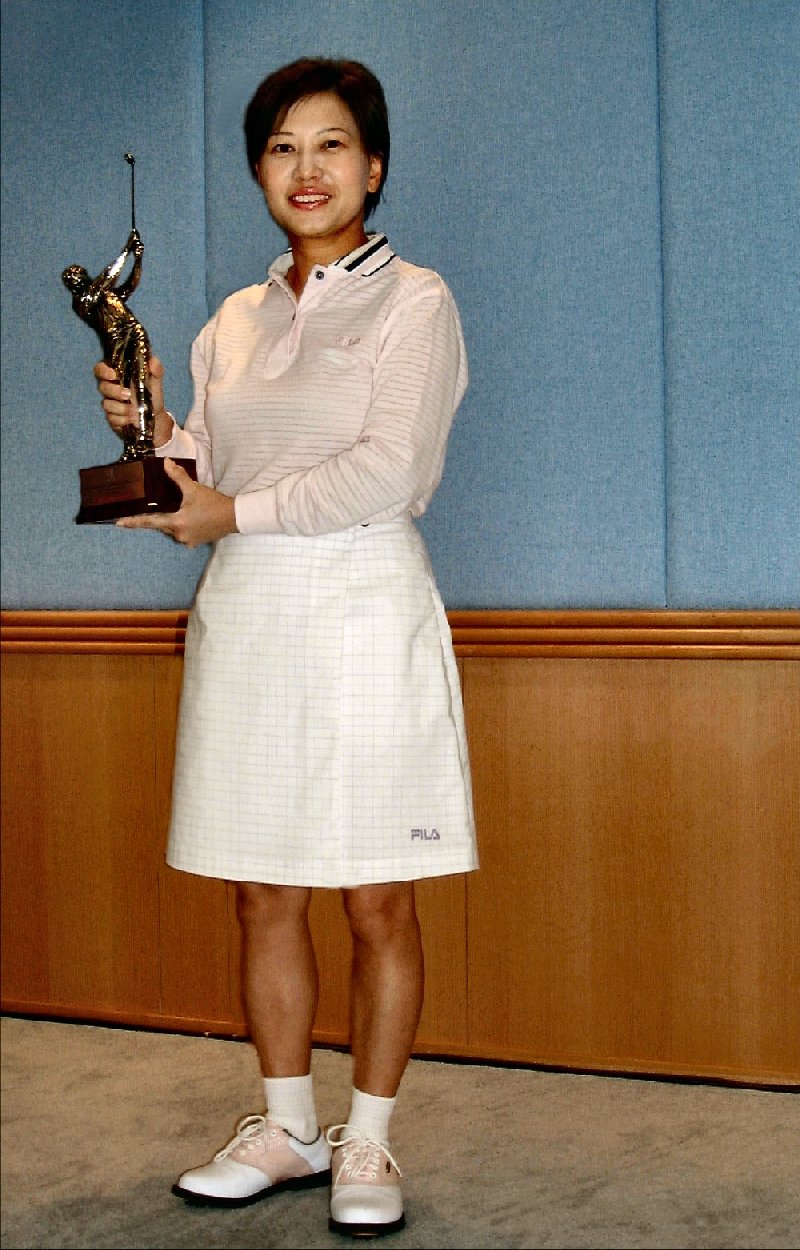 Competitive
sports require an enormous investment of effort and strength. But at the point
of release, strength and effort must come to an end and the shot must be
executed in a state of peace. Ancient Chinese writers said, "Draw the bow
in a state of tension and release it in a state of relaxation."
Competitive
sports require an enormous investment of effort and strength. But at the point
of release, strength and effort must come to an end and the shot must be
executed in a state of peace. Ancient Chinese writers said, "Draw the bow
in a state of tension and release it in a state of relaxation."
We all know that Chinese people value the balance of 'yin and yang'. But few in the West understand that yin and yang don't settle into a natural state of balance like an evenly-weighted pair of scales. The balance of yin and yang is like an acrobat on top of a pole. To get up the pole, the acrobat must exert himself; but once there, the slightest untoward motion or emotion will topple him off.
Chinese writers listed things that could cause one's performance to topple: wanting to shoot too much; not wanting to shoot at all; being in a hurry to reach the archery ground; being in a hurry to finish shooting.
Alice studied and applied the lesson of Li Chengfen:
"You are on the road to battle, the sky darkened with flags and pennants, the ground shaking with the crash of gongs and cymbals, the sun obscured by the blades of the enemy, the dust churned by the hooves of the advancing nomads' horses. With each thump of your heart, your hands shake and a chill enters your body. The hand that on a normal day can shoot through seven layers of leather armour must not let you down on this day!"
She emptied her mind and thought back to her practice sessions, her mind freed of any limitation, swinging her club on an empty course in the sunshine.
Alice won the competition with a drive of more than 230 yards.
(My thanks to Alice for the technical details, and for letting me reveal her weight!)
Last month, I described my travels to Qinghai (Amdo) and Xinjiang. While there, I was given the opportunity to study a number of bows preserved in Xinjiang's Institute of Archaeology and the museums at Urumqi and Turfan.
I had the chance to study three types of bow, all three of which had at one time or another been buried like mummies in the frozen, dry sands of the Xinjiang deserts. One of the bow groups I studied dated from the very end of the Han Dynasty or into the Wei-Jin period. That is, from around 250-350CE.
On studying this group of three, almost identical bows closely, a couple of points became immediately clear.
First, the description of the Niya bow in "Archaeological Treasures of the Silk Road in Xinjiang Uygur Autonomous Region" Ed. Ma Chengyuan, Yue Feng. Shanghai Publishing Translation House, 1998, in conjunction with the illustrations in the January 2000 edition of the Chinese archaeological journal, 'Wen Wu' (2000/1), had been misleading. All the illustrations had concentrated on a side view and had failed to do justice to the form of the bow when seen from the front. Furthermore, the person who did the drawings of the Niya bow also faithfully reproduced the effect of the distortion of the wood on the original item, but in the process gave an exaggerated impression that the length of the limbs were very different. In fact, optically, the limbs on these bow are identical in length.
The second point was that, clearly, the bows I was observing were full working bows of the same design described in my previous letter on the Gansu Bow. These bows show beyond doubt that my Gansu Bow was a full-scale model in wood of a bow that would normally be made of wood, sinew and horn.
The second point is of some importance in itself. Despite reading frequently of 'model bows' placed in graves, the 'Gansu Bow' is only the second certain example I have come across. (The first is a Liao Dynasty wooden model of a bow and box quiver .)
My examination of the three bows in the Museums gave me a chance to glean some data and correct general wrong preconceptions about these bows. However, everything I examined was behind glass and I was not permitted to take photographs (although I could sketch to my heart's content.) Even my measurements had to be estimated (supplemented by earnest attempts by the archaeologists with me to recall actual measurements.) The golden opportunity came, however, when a junk dealer in Xinjiang sold me one half of an original bow (together with one half of the original string and six arrows) that had come from Khotan. So identical was this bow to those I had seen in the museums that I have no hesitation in saying that this 'Khotan bow' provides a basis for a detailed description of the 'Niya Bow' genus.
I have been generously helped by Mr W. F. Lai, Conservator of the Hong Kong Museum of History. He helped with the measurement process and has undertaken the X-ray photography. In a later newsletter, he will provide identification of the wood and other materials used in making the bow. At this point, I'll cut the cackle and let you see photographs of the bow, with my observations.
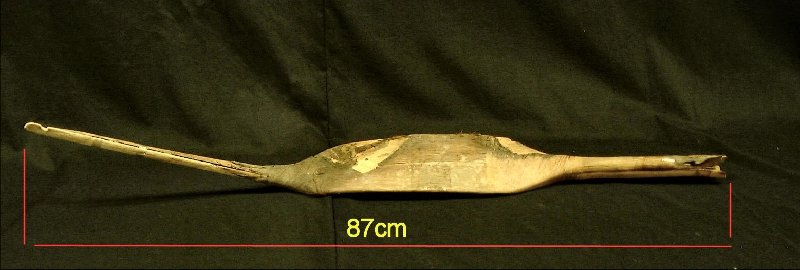

Back view. Bone limb reinforcement present on one side only. A
triangle of silk adheres to the top of the limb.

X-ray through back of the bow. (Composite of three.)


Side view of the grip, limb and siyah with surface
measurements.

X-ray through grip, limb and siyah
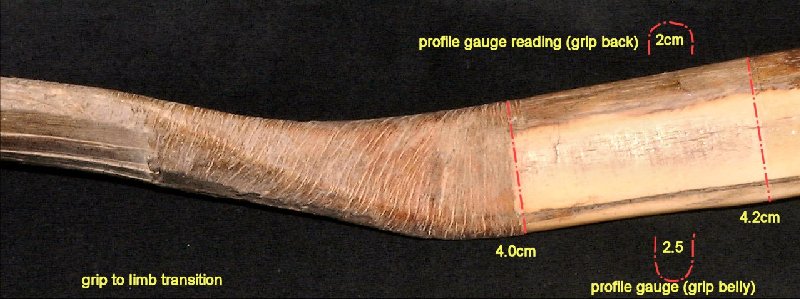
Detail of sinew reinforcement at limb/grip junction and bone
plates reinforcing side and belly of grip.
(The profile of the back of the grip is formed with sinew.)
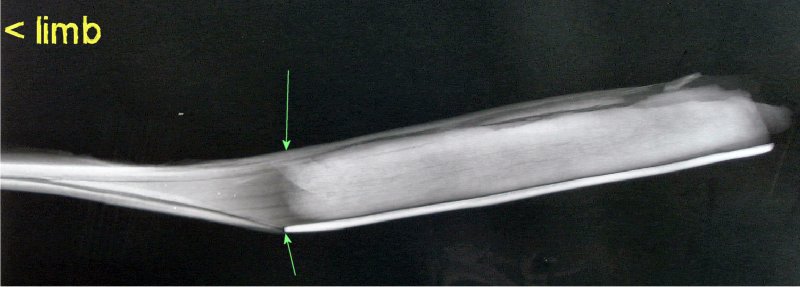
X-ray through the limb/grip junction.
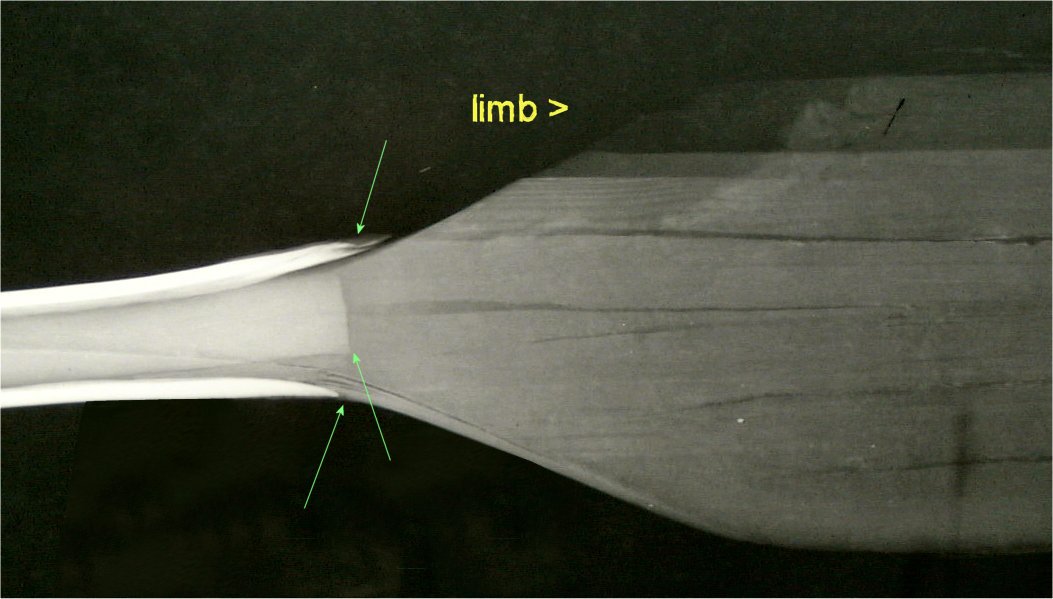
X-ray through grip/limb transition

The belly of the limb, formed of five horn plates over wood.
(Adhesive tape across the middle.) Lowest plate is missing.
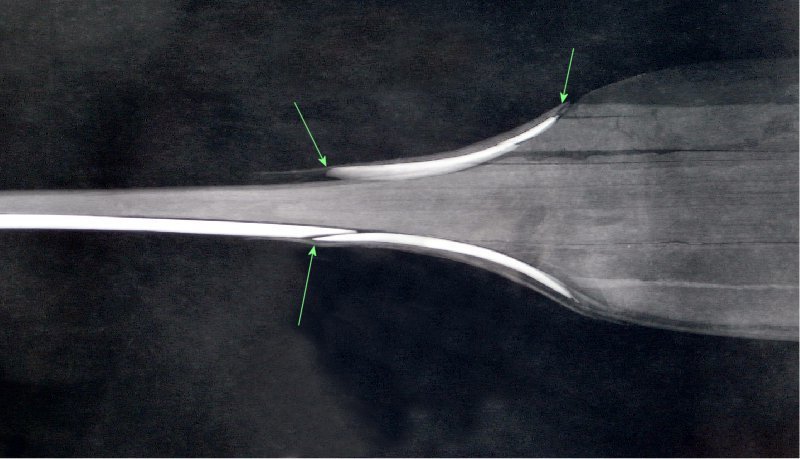
X-ray through siyah/limb transition from back. Sinew
(see picture below) hides additional bone reinforcements .
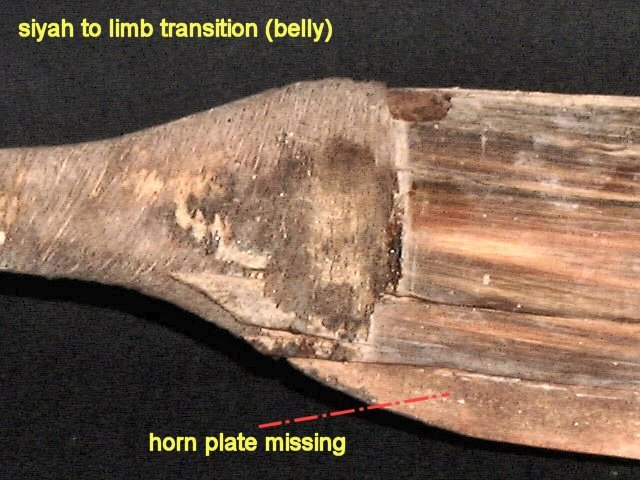
Detail of siyah/limb transition with sinew reinforcement.
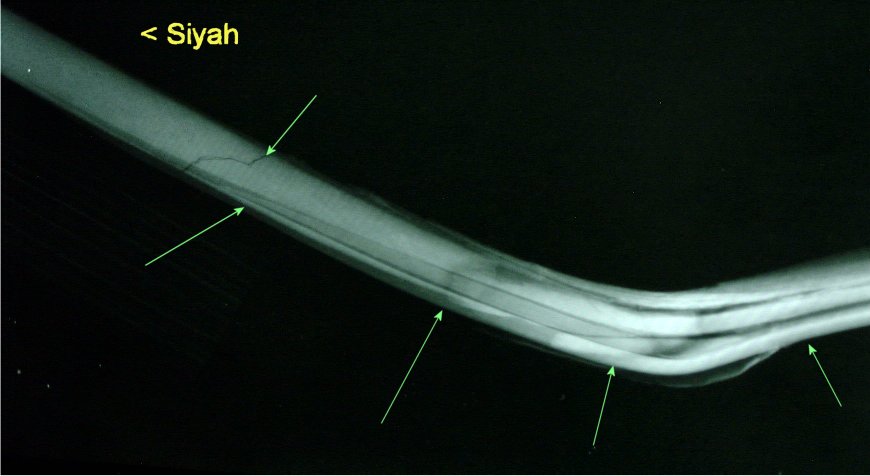
X-ray through siyah/limb transition from side shows up an
extension of horn along the belly of the siyah.
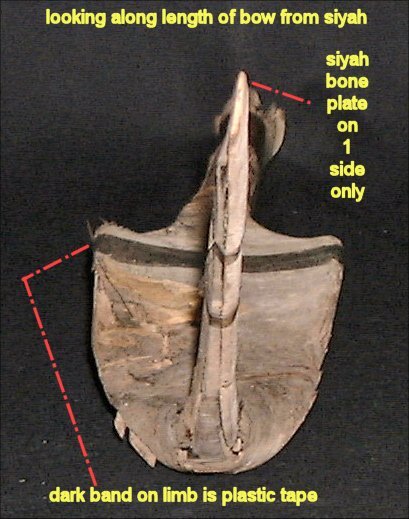
The bow viewed from the tip looking towards the grip
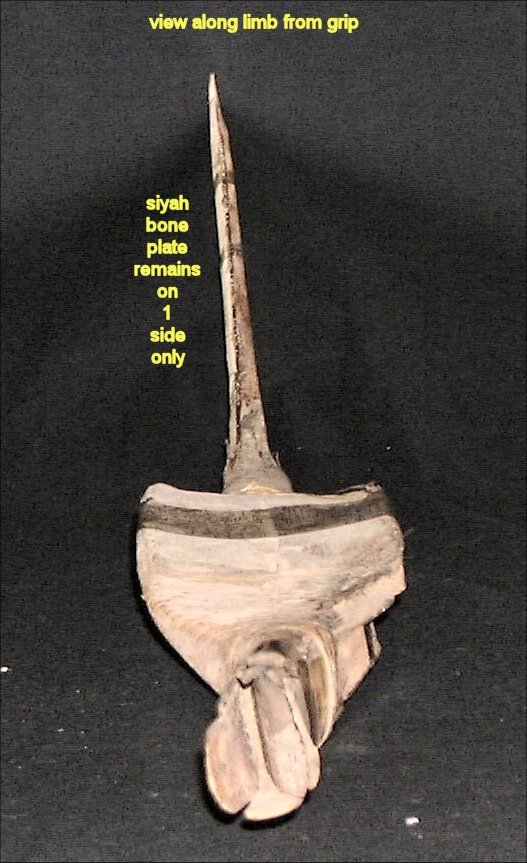
Looking from the grip to the siyah
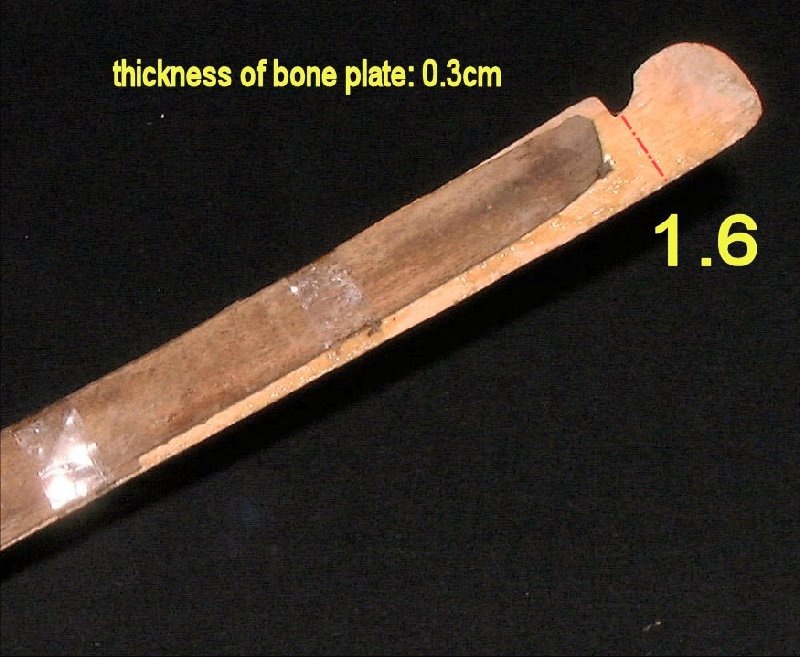
The bone reinforcement to the tip/siyah. I surmise that the
extent of the wooden core was originally the same as the bone reinforcement.
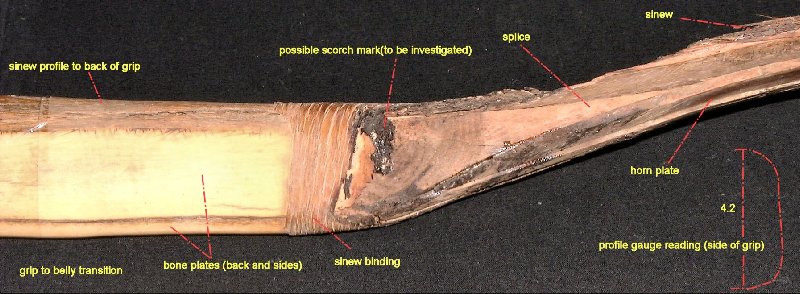
This photograph provides clues to the construction of the
grip/limb transition.
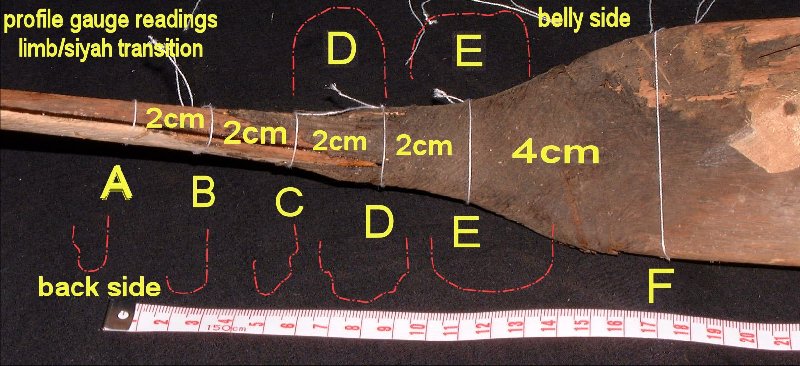
Cotton thread tied at measured intervals, with contour
gauge readings from the back (and belly at D, E.)

X-ray through grip from the back shows splice of limb/grip and
interstitial wood insert in the grip.

What remains of the original string.
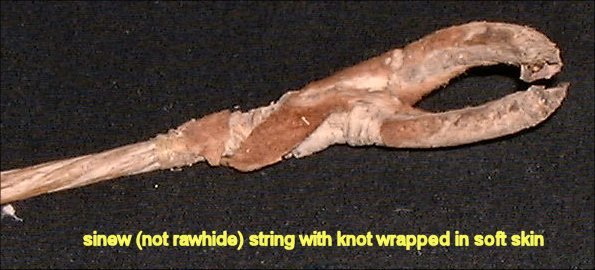
The loop seems to have been formed like a modern bow string and
then wrapped in the skin of a small, furry animal.
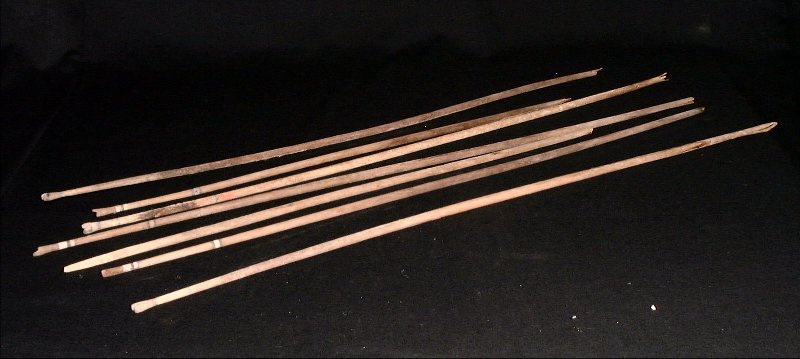
Six original self wooden arrows. But the points have all been
snapped off before burial.
Arrow Measurements
| Length(cm) | Max. diameter(cm) | Min. Diameter(cm) |
| 80.4 | 0.995 | 0.770 |
| 74.4 | 0.910 | 0.610 |
| 60.6 | 0.910 | 0.605 |
| 76.8 | 0.910 | 0.605 |
| 75.8 | 0.910 | 0.605 |
| 61.0 | 0.895 | 0.715 |
| 78.4 | 0.905 | 0.710 |
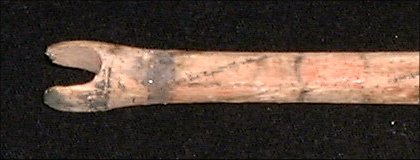
Self-wood bulbous nock. Painted, but no sign of reinforcement
or inserts.
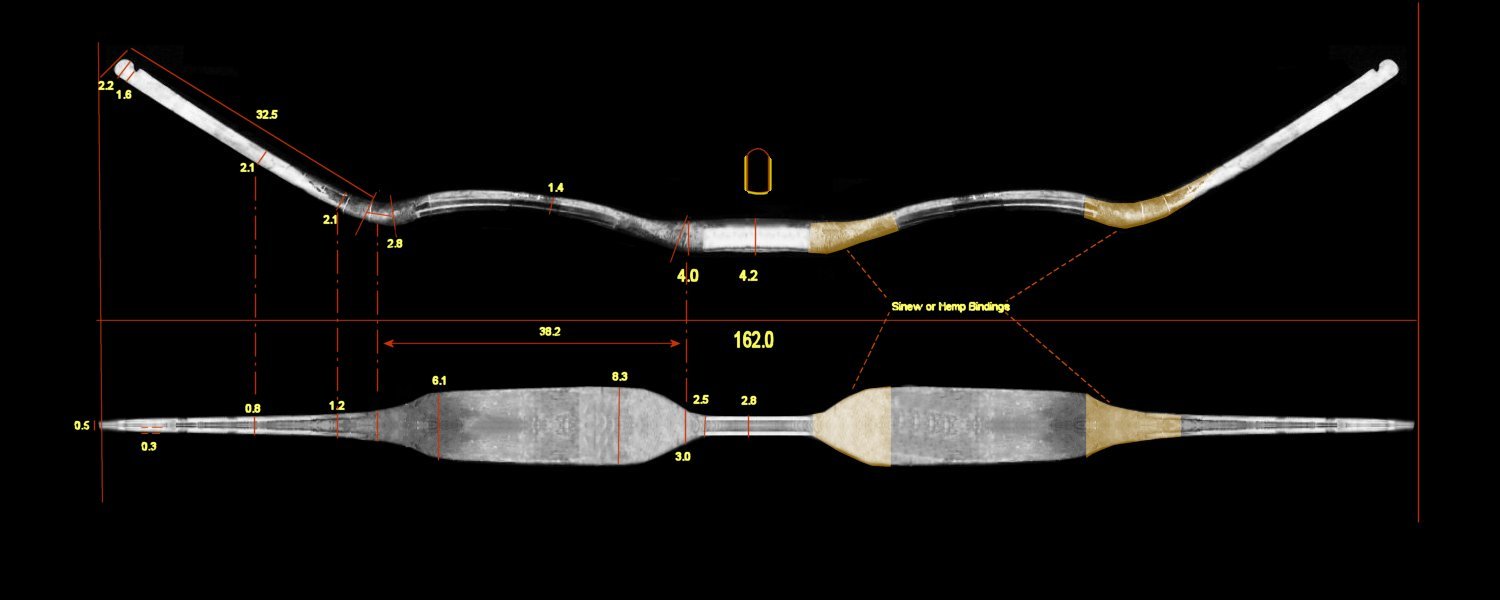
Here, I use computer magic to repair the bow and supply dimensions. This
exercise assumes symmetry around two axes.
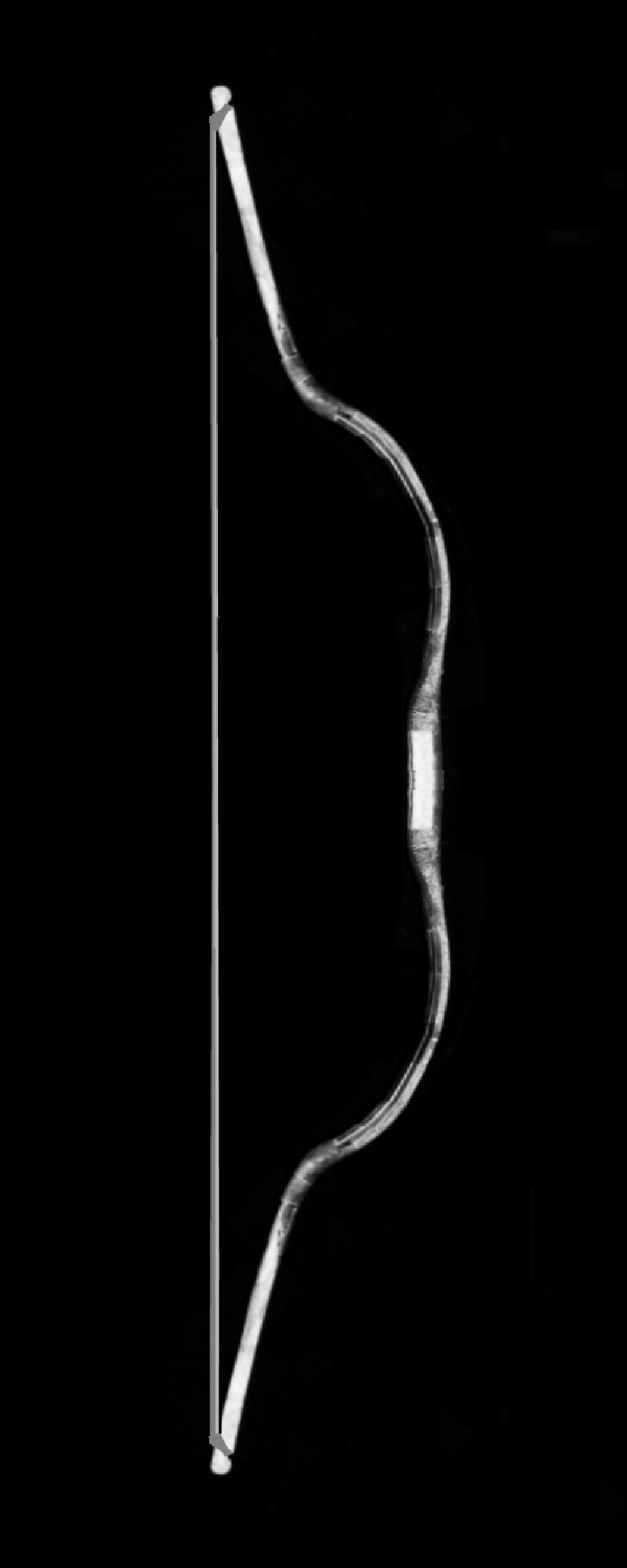
More computer magic: ready to shoot!
Archaeological and historical background of the Khotan bows.
A bow of identical design to the one I have just described was excavated at Niya on 11 October 1995. A coffin containing four male mummies and two bows was exhumed unopened and then examined in relatively ideal laboratory conditions in Urumqi in the following months. The description of the contents of the coffin from grave #4 at cemetery #95 at Niya was published in "Xinjiang Wenwu" ('Xinjiang Cultural Relics') Issue No. 2 of 1999, p. 27. There is some further comment in Wang Binghua (with Victor H. Mair), "The Ancient Corpses of Xinjiang", Xinjiang People's Press, 2002. ISBN 7-228-05161-0. Further background information (in Chinese) and illustrations is provided in Liu Wei: "Chinese Civilization in a New Light" Vol. 4. Commercial Press, Hong Kong, 2001. ISBN 962-07-5307-0.
The Niya site corresponds geographically to the location of a culture which occupied the Niya area throughout the Eastern Han and Western Jin periods, around 200-350CE. Situated in the remote desert, Niya was once irrigated by the Niya river, fed by the melting snows of the Kunlun Mountains.
In Chinese literature, the people occupying that region in those times were known as the 'Jingjue' (精絕). The 'Official History of the Han: Record of the Western Regions' (漢書西域傳) records that the Jingjue were one of 36 large and small vassal states in the West of the Empire. 480 households with a total population of over 3,000 people were recorded. Their armed forces amounted to 500 men. The Han government posted four officials there for administrative purposes. An invasion of the region by the Tuguhun in the fifth century caused economic disruption. Water supply to the Niya river was cut of and the desert encroached. (Archaeological surveys by Aurel Stein in the 19th Century and surveys by Chinese and Japanese archaeologists since the 1950s suggest, however, that the area was abandoned over a rather short period, with many valuable items left scattered.) By the time that the Tang monk-explorer Xuanzhang passed the site in the 7th Century, it was already a ruin.
The mummified remains from Cemetery #95 generally display non-Chinese racial characteristics, with light brown or blond hair and high, aquiline noses. Men were around 1.65 meters tall. They lived in a prosperous community which enjoyed the best luxury products from both East and West. Foods preserved in graves show that their diet was mainly mutton, grains and dried fruits (in fact, much the same as present-day inhabitants of the region.) Particularly striking (partly because their spectacular state of preservation) are the embroidered cloths in silk and wool that the mummies are buried in. The people were literate. In common with other cultures in the region at that time, they kept civil records in the Kharoşţh-ī-Prakrit script, that originated in Northern India.
Several of the deceased at Niya had died violently. Males were buried together with grave goods which in most cases included a bow, bow-case, quiver and arrows. Bows were clearly standard, emblematic burial items for males. Most of the bows were composite bows such as the one described here; but simple wood self bows about 1.5m long were also found. Arrows were self wood barreled and either had blunt wooden points, or else had had metal arrowheads removed before burial. Women were buried with make-up kits and items related to sewing and weaving. Where coffins were placed above previous burials, the previous burials were sometimes burned.
Coffin #4 from cemetery #95 also contained a piece of brocade with a vivid design of mounted archers using bows that were consistent with the design of the bow described here. Another mummy discovered nearby had a brocade bracer on his arm, embroidered with the Chinese text "Five stars appear in the East: the Central States will benefit and the Southern Qiang will be punished." This brocade may be a gift from the Chinese court to minority tribes who helped the Chinese to suppress incursions from the Southern Qiang (Tibetans.)

A piece of brocade with a vivid design of mounted
archers using bows consistent with the design of the bow described here.
(Based on an illustration in Xinjiang Wenwu"
('Xinjiang Cultural Relics') Issue No. 2 of 1999.)
You may copy and make non-commercial use of this drawing.
Commentary
Feeling a sense of déja-vu? Open 'The Traditional Bowyer's Bible', Vol. 3 at page 82. Look at Tim Baker's suggestion for a theoretical design for maximized performance of a composite bow. Someone got around to trying out his design... 1,700 years ago.
In this bow design, the working limbs amount to little more than spring-leaf hinges. From the X-rays, we can see that the bow needed careful reinforcement at the edges of regions where the working sections and non-working sections are spliced. We also see that the central horn plate of the belly extends half-way up the siyah. As far as can be ascertained, the wooden core consists of two pieces of wood, each carved in one piece from the tip to the grip, with a short interstitial piece of wood between them.
While Tim Baker anticipates the short, rectangular working limb, he does not anticipate the spoon-shaped hollowing of the limbs (which is corroborated by the Gansu bow.) Without actually constructing this bow, it is difficult to understand the purpose of such a feature. Personally, I could imagine the hollow-profile limb giving rises to enormous stresses at the edges. What happened in reality?
One element of the design helps to deal with a problem that we observed in the area where these bows were made: there is little prospect of obtaining long sections of good, consistent horn and the principal woods are light and lack hardness and sappiness. The short working limb permits the use of short plates of horn. The addition of slivers of bone (horse or camel) as reinforcement allows construction of very light but strong non-working sections. I would go as far as to say that this bow is principally constructed of bone, horn and sinew: the role of the wood core in the construction is limited to a scaffolding to facilitate the assembly of the other materials.
For a further interactive discussion of this bow, please look for the new discussion topic on ATARNet.
(Follow-up discussion up to 21 July 2002 can be seen here.)
|
|
(Signed) (Stephen Selby) |